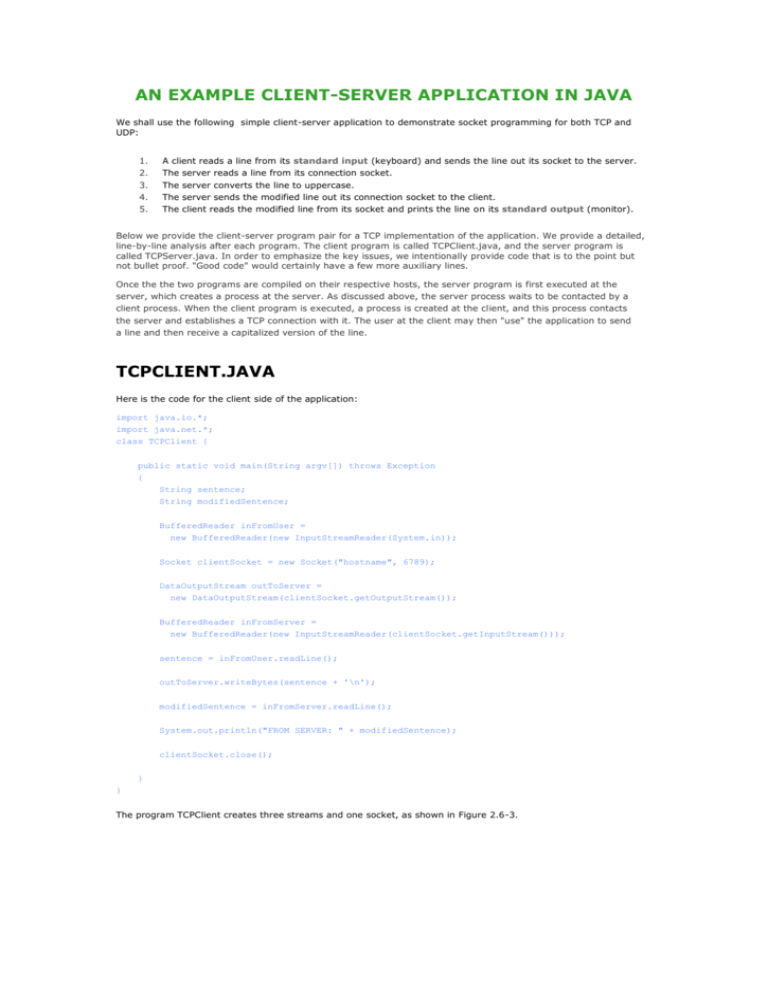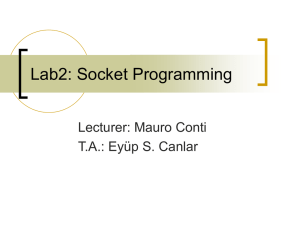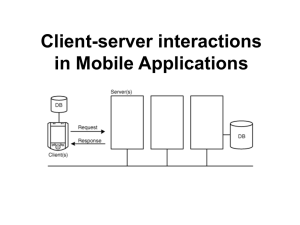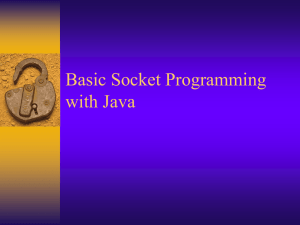Java TCP Client-Server Example
advertisement

AN EXAMPLE CLIENT-SERVER APPLICATION IN JAVA
We shall use the following simple client-server application to demonstrate socket programming for both TCP and
UDP:
1.
2.
3.
4.
5.
A client reads a line from its standard input (keyboard) and sends the line out its socket to the server.
The server reads a line from its connection socket.
The server converts the line to uppercase.
The server sends the modified line out its connection socket to the client.
The client reads the modified line from its socket and prints the line on its standard output (monitor).
Below we provide the client-server program pair for a TCP implementation of the application. We provide a detailed,
line-by-line analysis after each program. The client program is called TCPClient.java, and the server program is
called TCPServer.java. In order to emphasize the key issues, we intentionally provide code that is to the point but
not bullet proof. "Good code" would certainly have a few more auxiliary lines.
Once the the two programs are compiled on their respective hosts, the server program is first executed at the
server, which creates a process at the server. As discussed above, the server process waits to be contacted by a
client process. When the client program is executed, a process is created at the client, and this process contacts
the server and establishes a TCP connection with it. The user at the client may then "use" the application to send
a line and then receive a capitalized version of the line.
TCPCLIENT.JAVA
Here is the code for the client side of the application:
import java.io.*;
import java.net.*;
class TCPClient {
public static void main(String argv[]) throws Exception
{
String sentence;
String modifiedSentence;
BufferedReader inFromUser =
new BufferedReader(new InputStreamReader(System.in));
Socket clientSocket = new Socket("hostname", 6789);
DataOutputStream outToServer =
new DataOutputStream(clientSocket.getOutputStream());
BufferedReader inFromServer =
new BufferedReader(new InputStreamReader(clientSocket.getInputStream()));
sentence = inFromUser.readLine();
outToServer.writeBytes(sentence + '\n');
modifiedSentence = inFromServer.readLine();
System.out.println("FROM SERVER: " + modifiedSentence);
clientSocket.close();
}
}
The program TCPClient creates three streams and one socket, as shown in Figure 2.6-3.
Figure 2.6-3: TCPClient has three streams and one socket.
The socket is called clientSocket. The stream inFromUser is an input stream to the program; it is attached to
the standard input, i.e., the keyboard. When the user types characters on the keyboard, the characters flow into
the stream inFromUser. The streaminFromServer is another input stream to the program; it is attached to the
socket. Characters that arrive from the network flow into the stream inFromServer. Finally, the
stream outToServer is is an output stream from the program; it is also attached to the socket. Characters that
the client sends to the network flow into the stream outToServer.
Let's now take a look at the various lines in the code.
import java.io.*;
import java.net.*;
java.io and java.net are java packages. The java.io package contains classes for input and output streams. In
particular, the java.io package contains the BufferedReader and DataOutputStream classes, classes that the program
uses to create the three streams illustrated above. The java.net package provides classes for network support. In
particular, it contains the Socket and ServerSocketclasses. The clientSocket object of this program is derived from
the Socket class.
class TCPClient {
public static void main(String argv[]) throws Exception
{......}
}
The above is standard stuff that you see at the beginning of most java code. The first line is the beginning of a
class definition block. The keyword class begins the class definition for the class named TCPClient. A class
contains variables and methods. The variables and methods of the class are embraced by the curly brackets that
begin and end the class definition block. The class TCPClient has no class variables and exactly one method, the
main( ) method. Methods are similar to the functions or procedures in languages such as C; the main method in
the Java language is similar to the main function in C and C++. When the Java interpreter executes an application
(by being invoked upon the application's controlling class), it starts by calling the class's main method. The main
method then calls all the other methods required to run the application. For this introduction into socket
programming in Java, you may ignore the keywords public, static, void, main, throws Exceptions (although you
must include them in the code).
String sentence;
String modifiedSentence;
These above two lines declare objects of type String. The object sentence is the string typed by the user and
sent to the server. The object modifiedSentence is the string obtained from the server and sent the user's
standard output.
BufferedReader inFromUser =
new BufferedReader(new InputStreamReader(System.in));
The above line creates the stream object inFromUser of type BufferedReader. The input stream is initialized with
System.in, which attaches the stream to the standard input. The command allows the client to read text from its
keyboard.
Socket clientSocket = new Socket("hostname", 6789);
The above line creates the object clientSocket of type Socket. It also initiates the TCP connection between client
and server. The variable "host name" must be replaced with the host name of the server (e.g.,
"fling.seas.upenn.edu"). Before the TCP connection is actually initiated, the client performs a DNS look up on the
hostname to obtain the host's IP address. The number 6789 is the port number. You can use a different port
number; but you must make sure that you use the same port number at the server side of the application. As
discussed earlier, the host's IP address along with the applications port number identifies the server process.
DataOutputStream outToServer =
new DataOutputStream(clientSocket.getOutputStream());
BufferedReader inFromServer =
new BufferedReader(new inputStreamReader(clientSocket.getInputStream()));
The above two lines create stream objects that are attached to the socket. The outToServer stream provides the
process output to the socket. The inFromServer stream provides the process input from the socket. (See
diagram above.)
sentence = inFromUser.readLine();
The above line places a line typed by user into the string sentence. The string sentence continues to gather
characters until the user ends the line by typing a carriage return. The line passes from standard input through
the stream inFromUser into the stringsentence.
outToServer.writeBytes(sentence + '\n');
The above line sends the string sentence augmented with a carriage return into the outToServer stream. The
augmented sentence flows through the client's socket and into the TCP pipe. The client then waits to receive
characters from the server.
modifiedSentence = inFromServer.readLine();
When characters arrive from the server, they flow through the stream inFromServer and get placed into the
stringmodifiedSentence. Characters continue to accumulate in modifiedSentence until the line ends with a
carriage return character.
System.out.println("FROM SERVER " + modifiedSentence);
The above line prints to the monitor the string modifiedSentence returned by the server.
clientSocket.close();
This last line closes the socket and, hence, closes the TCP connection between the client and the server. It causes
TCP in the client to send a TCP message to TCP in the server (see Section 3.5).
TCPSERVER.JAVA
Now let's take a look at the server program.
import java.io.*;
import java.net.*;
class TCPServer {
public static void main(String argv[]) throws Exception
{
String clientSentence;
String capitalizedSentence;
ServerSocket welcomeSocket = new ServerSocket(6789);
while(true) {
Socket connectionSocket = welcomeSocket.accept();
BufferedReader inFromClient =
new BufferedReader(new InputStreamReader(connectionSocket.getInputStream()));
DataOutputStream outToClient =
new DataOutputStream(connectionSocket.getOutputStream());
clientSentence = inFromClient.readLine();
capitalizedSentence = clientSentence.toUpperCase() + '\n';
outToClient.writeBytes(capitalizedSentence);
}
}
}
TCPServer has many similarities with TCPClient. Let us now take a look at the lines in TCPServer.java. We will not
comment on the lines which are identical or similar to commands in TCPClient.java.
The first line in TCPServer that is substantially different from what we saw in TCPClient is:
ServerSocket welcomeSocket = new ServerSocket(6789);
The above line creates the object welcomeSocket, which is of type ServerSocket. The WelcomeSocket, as
discussed above, is a sort of door that waits for a knock from some client. The port number 6789 identifies the
process at the server. The following line is:
Socket connectionSocket = welcomeSocket.accept();
The above line creates a new socket, called connectionSocket, when some client knocks on welcomeSocket. TCP
then establishes a direct virtual pipe between clientSocket at the client and connectionSocket at the server.
The client and server can then send bytes to each other over the pipe, and all bytes sent arrive at the other side
in order. With connectionSocket established, the server can continue to listen for other requests from other
clients for the application using welcomeSocket. (This version of the program doesn't actually listen for more
connection requests. But it can be modified with threads to do so.) The program then creates several stream
objects, analogous to the stream objects created in clientSocket. Now consider:
capitalizedSentence = clientSentence.toUpperCase() + '\n';
This command is the heart of application. It takes the line sent by the client, capitalizes it and adds a carriage
return. It uses the method toUpperCase(). All the other commands in the program are peripheral; they are used
for communication with the client.
That completes our analysis of the TCP program pair. Recall that TCP provides a reliable data transfer service.
This implies, in particular, that if one the user's characters gets corrupted in the network, then the client host will
retransmit the character, thereby providing correct delivery of the data. These retransmissions are completely
transparent to the application programs. The DNS lookup is also transparent to the application programs.
To test the program pair, you install and compile TCPClient.java in one host and TCPServer.java in another host.
Be sure to include the proper host name of the server in TCPClient.java. You then execute TCPServer.class, the
compiled server program, in the server. This creates a process in the server which idles until it is contacted by
some client. Then you execute TCPClient.class, the compiled client program, in the client. This creates a process
in the client and establishes a TCP connection between the client and server processes. Finally, to use the
application, you type a sentence followed by
a carriage return.
To develop your own client-server application, you can begin by slightly modifying the programs. For example,
instead of converting all the letters to uppercase, the server can count the number of times the letter "s" appears
and return this number.








